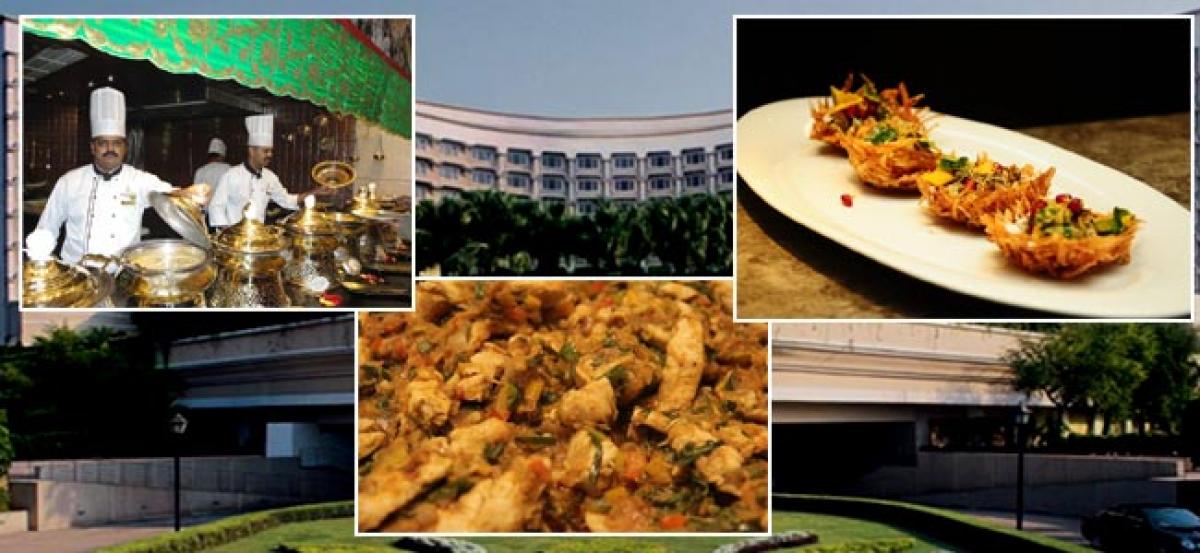Live
- NASA Tracks Five Giant Asteroids on Close Approach to Earth Today
- Pushpa 2 Hits ₹1000 Crore in 6 Days: How It Compares to Other Top Indian Films
- Vivo X200 and X200 Pro Launched in India: Price, Specifications, and Features
- Nitin Gadkari Admits Feeling Embarrassed at Global Summits Over Rising Road Accidents in India
- Comprehensive Review on Indiramma Housing Survey and Welfare Initiatives Conducted via Video Conference
- Jogulamba Temple Records Rs 1.06 Crore Hundi Revenue in 150 Days
- Opposition Slams ‘One Nation, One Election’ Bill as Anti-Democratic; BJP Allies Support the Move
- Celebrate Karthigai Maha Deepam Virtually with Sri Mandir’s LIVE Darshan Experience
- BJP Extends Support to Samagra Shiksha Abhiyan Employees' Strike, Demands Immediate Regularization and Welfare Benefits
- Dr. M. Priyanka Stresses Quality Education, Nutritious Meals, and Cleanliness in Schools
Just In

Royal and age-old tradition is what describes The Oudh, bringing Lakhnavi cuisine directly from the kitchens of the last nawab of Awadh, Wajid Ali Shah, on to the plates of Delhiites.
New Delhi: Royal and age-old tradition is what describes The Oudh, bringing Lakhnavi cuisine directly from the kitchens of the last nawab of Awadh, Wajid Ali Shah, on to the plates of Delhiites.
The Oudh, formerly known as Darbar, located in The Ashok, opened its doors in 1995 offering an array of dishes that were created by the bawarchis (chefs) and rakabdars (gourmet cooks) who were employed by the nawab.
Awadhi cusine is very much influenced by Mughal cooking techniques that vary from mild to spicy with a distinctive aroma and the dishes bear similarities to the ones from Kashmir, Hyderabad and Punjab. The dum style of cooking or cooking over a slow fire originated in this region, a technique which is synonymous with Lucknow today.
Sprawled across the lush green Lily Pool Lawns, The Oudh is a treat for the sore eyes. Red, gold and silver dominate the interiors, giving out a very distinct royal feel. The walls are decorated with 'minakari' art and 'jalis' (latticed screens) along with paintings and other marble work. It can seat up to 80 people along with two private rooms. Lunch comprises a buffet spread while dinner is purely a la carte.
"Since we opened back in 1995, the food has pretty much remained the same, including an addition or an exclusion every now and then but we make sure that there is no compromise on the taste. We still use ancient recipes to get the actual taste of the rich Awadhi cusine," Food and Beverage Manager Asad Fayyaz told IANS.
The menu is a masterpiece in itself with the incorporation of different host and guest menus. It also comes in eight different languages - English, Hindi, French, Spanish, Chinese, Japanese, Russian and Flemish.
"In our menu, we do not include the prices of the dishes as we want our customers to order without holding themselves back when they see the amount. This food is to be taken for leisure and not worrying about the price tag," Fayyaz added.
To start my royal nawabi trail, I was served a Chashme Baddoor welcome drink. A sweet, refreshing drink but the addition of a bit too much of cumin became quite overwhelming for my taste buds. This was followed by an array of fragrant appetisers comprising lehsuni malai tikka, galawat kebab, tohfa-e-noor (cottage cheese rolls), haryali kebab, mahi-e-gulfam (fish) and paneer tikka.
The one that really stood out in terms of taste was the galawat kebab, which, according to Fayyaz, is a favourite among restaurant regulars. Made of minced mutton and a combination of various spices, the kabab has a melt-in-the-mouth goodness. The hariyali kabab, mahi-e-gulfam (fish prepared over charcoal) and paneer tikka were equally excellent.
However, the dishes that did not really hit the mark were the lehsuni malai tikka, which was really dry and bland, and the tohfa-e-noor, which is one of the restaurant's best-selling dishes but is on the heavier side.
The mains included murgh rihana-barbequed chicken cooked in a gravy of cashew nuts, tomato and cream: tender, succulent and juicy pieces of chicken in a creamy gravy, a riot of flavours.
The second was koh-e-Daliganj or mutton cooked in an onion and cashewnut gravy. The meat was fall-off-the-bone, looked very spicy but the spice level was mild. Dal Oudhi, a rich but not-so-heavy dal dish, made me feel very royal. The two other entrees-paneer hazrat mahal and the Nishatganj ki jhalfarezi-could easily be given a miss.
They were all served with Roomali roti and Warqi Paratha, an Awadhi flaky bread.
The next dish was definitely the star of the entire luncheon: dum mutton biryani. It came in a sealed earthen pot which helped to retain all its flavours. The al dente rice was fragrant, and the addition of burnt onion elevated the dish. The mutton was cooked to perfection and fell right off the bone.
Next up were desserts-qulfi falooda, firnee, khush zaiqa (milk dumplings fried and soaked in sugar syrup) and gulab jamun. The royal trail finally ended with a paan.
In conclusion, The Oudh actually transports you to a time of eloquent dining where the kings and queens were offered the best of the best.
FAQs:
Where: The Ashok, 50 B, Diplomatic Enclave, Chanakyapuri, New Delhi
Cost for two: Rs. 3,000 (without alcohol); Rs. 4,000 (with alcohol)
Timing: 12.30 p.m.-3 p.m., 7.30 p.m-11.30 p.m.

© 2024 Hyderabad Media House Limited/The Hans India. All rights reserved. Powered by hocalwire.com







